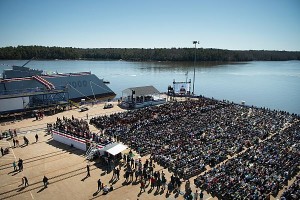 In the Trump Era, “Big Defense” CEOs must either market themselves as visionary, “national” assets or wait to die under withering attack from the White House.
In the Trump Era, “Big Defense” CEOs must either market themselves as visionary, “national” assets or wait to die under withering attack from the White House.
Look, for any defense company has a big marquee program like the F-35, the Ford Class Carrier or the SSBN(X), being a colorless, faceless and largely anonymous means of service delivery is, to the Trump Administration, a sign of exploitation-ready weakness.
I’ll be frank. Owners of large defense contracts can’t stealth their way out of this. They’ll need to be either feared or liked by the Trump Administration. There is no middle ground.
For those sad companies that the Trump Administration neither fear nor have a reason to like, well, they’re at real risk. Un-feared and unloved, they will be little more than prey–a herd of slow-moving old-school Corporate Brontosauruses just waiting around to be ravaged by a hungry, savvy and marketing-focused Trump-osaurus Rex. The mechanism will be simple and brutal–whenever the Trump Administration needs a quick domestic win, then those faceless, anonymous contractors will be the first to see their programs challenged and, possibly, sacrificed.
No program–no matter how much they contribute to national security–is safe.
 Eating the Brontosaurus:
Eating the Brontosaurus:
This was easy to see coming. Early in December, I was “fairly certain the Trump Administration would relish the political theatre in killing off a defense program or two”. Days later, Mr. Trump sent out his “Cancel Order” tweet about Air Force One. Two weeks later, Mr. Trump was attacking the “out of control” F-35 on Twitter, and setting them in opposition to a somewhat desperate Boeing.
It makes sense.
Harassing a big contractor like Lockheed Martin or Boeing is a simple, easy way to get a political win–over the past decade, Lockheed, in particular, has taken American Government Business for granted. Lockheed has no real domestic “presence”, focusing the company’s public outreach on being an “international” company. Aside from some niche “STEM” outreach initiatives, Lockheed cannot make a strong case for why the company matters to Mr. Trump’s base and Mr. Trump’s overall political well-being.
Making matters worse, Lockheed’s CEO, Ms. Marylin Hewson, is not somebody who Mr. Trump is likely to warm up to either–she’s certainly competent, wily and smart as all get out, but she’s not somebody who is likely to have strong personal chemistry with Mr. Trump.
Politically, it is even worse for Lockheed. Lockheed has no identifiable geographical center. Instead, it has spread facilities around the country, focused on building strong relations with Congress. That’s fine, but….there’s also the problem of having too much of a good thing. Today, when raw theatrical politics count, Lockheed is left with a diverse, geographically distributed set of workplaces that, for a variety of reasons, don’t make good populist theatre.
An industrial tool built to influence Congress has little ability to impact the Executive Branch.
With a good relationship between Mr. Trump and Ms. Hewson unlikely, Lockheed has no easy way to convey threat to Trump. Electorally? Well, try and find a map on Lockheed’s website to show where they employ people in the USA. It’s hard to find. In the press? Lockheed only focuses on the specialist press. There’s nothing to show that Lockheed is tied to the folks Mr. Trump’s political engine needs.
To the average Trump voter, Lockheed is a non-entity.
Boeing is a bit better positioned–they’re motivated, they have executives that appear more likely to “click” with Mr. Trump, and they’ve got a strong presence in states the Trump Administration will need in the next election. So when Boeing needs some love to survive the upcoming trade war with China, Lockheed will be pilloried, and some of Lockheed’s work-share will handed over to Boeing.
 What to Do?:
What to Do?:
For any defense contractor that is too big to ignore, the route to survive is to go full populist. I warned Big Defense about their civic disconnect two years ago, writing:
It’s strange that the public image of the Big Defense CEOs seem–at least according to google’s image selection analytics–far too stodgy. Too stuck in the ‘90s. And it’s that sector-wide disconnect with today’s innovative business culture–a overtly populist edge–gives Mr. Musk and his other Silicon Valley confederates an opportunity to diminish their defense rivals. They’re taking full advantage–and it is one of the reasons why they–and not representatives of Big Defense companies–are being hailed as the champions of America’s technological future.
These tech populists have piqued America’s imagination, creativity and interest.
For the health of Big Defense, that’s gotta change.
Here’s what needs to happen:
 First, identify executives that are either likely to bond–or intimidate–Mr. Trump’s inner circle: If you have either a personable bon vivant or some kind of ex-CIA operative in the executive suite, direct them to build contacts within Trump’s inner circle. This doesn’t need to be the CEO–just somebody who is seen by those in Mr. Trump’s orbit as having influence on the CEO.
First, identify executives that are either likely to bond–or intimidate–Mr. Trump’s inner circle: If you have either a personable bon vivant or some kind of ex-CIA operative in the executive suite, direct them to build contacts within Trump’s inner circle. This doesn’t need to be the CEO–just somebody who is seen by those in Mr. Trump’s orbit as having influence on the CEO.
Second, get the CEO to go public and go American early and often: The American public adores high-profile CEOs, and the Trump Administration recognizes that the public, starved for dynamic leadership, turned to high-profile CEOs out there to fill the vacuum. Defense CEOs need to get smart, grab the American flag, wrap themselves in it, and align their products with apple pie, baseball and the American Way.
This will be a hard pill for companies like Lockheed to swallow–Lockheed has long-stated their goal will be to use international sales to boost the bottom line, and, to do that, the company has been shedding their “American” image/base. Unless Lockheed can convince the public (and Mr. Trump) that their international push is an American virtue, then…don’t highlight it. Focus on raw, blunt Americana.
Third, CEOs need to recognize both the American public and Mr Trump are more comfortable treating companies as personalities: It is no secret that the average taxpayer will spend more time reading biographies than they ever will commit to examining a company prospectus–That’s why Big Defense CEOs must put energy into crafting their public image. Any rags-to-riches story, a “scrappy winner” theme or spy story associated with a Big Defense CEO will be assimilated by the public far more quickly than a technical product portfolio—but once the public starts getting engaged in the CEO’s personal story, they’ll inevitably learn more about (and sympathize with) the wider company and their products, too.
It’s simple…if Lockheed can sell America (and Mr. Trump) on Ms. Marillyn Hewson (which I don’t think can be done easily), then Lockheed will have gone a long way towards securing sales of Lockheed’s major product lines. Same rules apply for General Dynamics, BAE and all the other Big Defense conglomerates.
Put another way, it’s time to move away from having defense products “sell themselves” to the taxpayer. Lacking a big challenge like the Cold War or the War on Terror, average taxpayers aren’t gong to be moved by an interesting (and critical) defense product, like, say, the F-35. But….that said, an average taxpayer might be more interested if the F-35 was woven into a part of a larger, more personality-oriented storyline (Like Mr. Musk putting it “all on the line” for Tesla, or Apple growing out of Steve Job’s garage, etc, etc).
That personalized approach is what Big Defense CEOs need to try.
Fourth, the CEO must sell a BIG vision to Americans:
Rather than focus on selling to the American government (let the corporate underlings do that), Big Defense CEOs need to get out there and sell a vision to the American taxpayer–and, well, if that vision is only achievable with their company’s products, all the better, right?
But they need to sell a vision. A mission. Listen to Mr. Trump’s speeches. Look at his career. A big sweeping vision sells. Define that vision and, like Mr. Elon Musk, place your company at the center of it.
 Finally, build some labor-heavy and identifiable geographical centers: If a company can’t generate good political theatre–creating a real and visceral political capital by rallying workers and so forth, then they’re vulnerable.
Finally, build some labor-heavy and identifiable geographical centers: If a company can’t generate good political theatre–creating a real and visceral political capital by rallying workers and so forth, then they’re vulnerable.
This is something of a retro move, but old defense contractors (Like, say the Krupp Family) used a similar tactic to survive and thrive in the face of monarchies, strong central governments or even (in Krupp’s Case) authoritarian ones. But it’s a lot harder for a leader to successfully harass a company that, in essence, funds and maintains, essentially, their own town. (After years of bemoaning their pricey Washington State presence, Boeing may learn to appreciate their status as the largest public employer in Washington State yet.)
It may, in the coming decade, be more important for companies to offer larger, more cohesive political blocks to the Executive Branch than to spread small bits of manufacturing around the country as a means to influence Congress.
Which, if we put this into maritime terms, means that it’s probably a pretty good time to own a shipyard.
